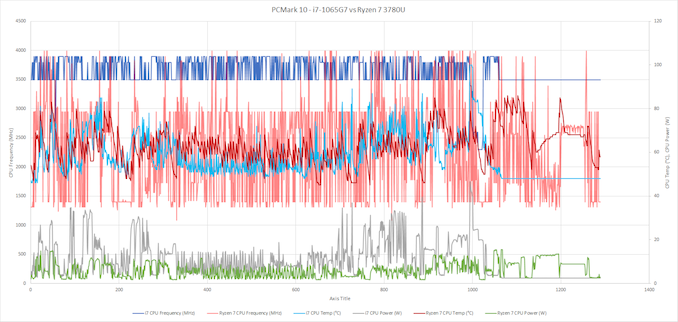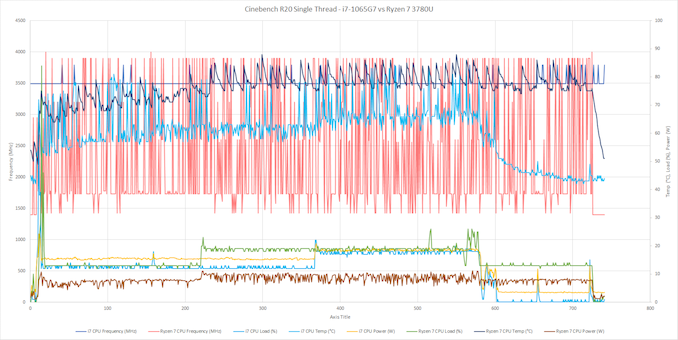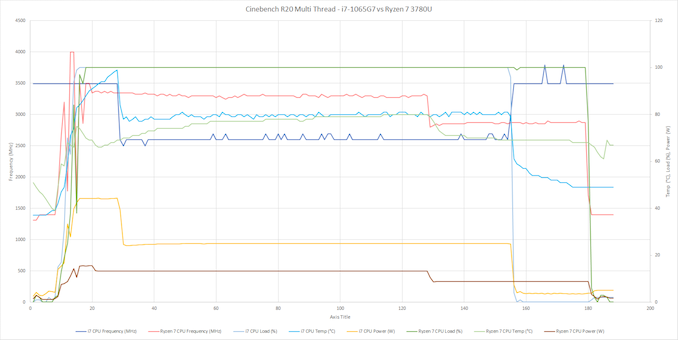The Microsoft Surface Laptop 3 Showdown: AMD's Ryzen Picasso vs. Intel's Ice Lake
by Brett Howse & Andrei Frumusanu on December 13, 2019 8:30 AM ESTBenchmark Analysis: Boost Behavior
Let’s dig into some of the testing to see how the systems responded during the benchmarks. We re-ran several of the tests while simultaneously monitoring the processor frequency, temperature, and power. Unfortunately for our comparison, the power polling results provided by our monitoring tools don’t seem to monitor the same power draw. The Intel power numbers are for the SoC package, but the AMD power numbers appear to be just the CPU cores, which is an unfortunate byproduct of testing two different platforms.
PCMark 10
PCMark 10 is a benchmark platform that attempts to simulate real-world tasks by running a variety of workflow, and the results were perhaps the most interesting of any of the benchmarks. There is a major discrepancy in how the AMD CPU behaved compared to the Intel. The Ice Lake platform kept the CPU frequency at a minimum of 3.5 GHz, with bursts to 3.9 GHz when under load. The Picasso processor was very aggressively switching from low frequency to high frequency, and was rarely indicating that it was over 3.0 GHz, but clearly demonstrating its higher peak frequency of 4.0 GHz in several locations. Both systems were fairly even in terms of CPU temperature, and Intel’s aggressive turbo levels were evident with peak power levels of 40 Watts for brief moments. The Ice Lake platform finished the benchmark about 200 seconds quicker than the Picasso system.
Cinebench R20 Single-Thread
We see somewhat similar results when only a single CPU core is loaded with the Picasso CPU frequency varying quite a bit. There’s also an average higher temperature on the AMD platform during this workload, and once again Ice Lake finishes the rendering quite a bit sooner thanks to its stronger CPU cores.
Cinebench R20 Multi-Thread
With all cores loaded the graph is considerably altered. Here the AMD processor is able to maintain a much higher frequency across its cores for much longer, while Intel's chip is only able to maintain 3.5 GHz for about 30 seconds before it runs out of headroom, dropping the cores down to around 2.6 GHz. But despite the lower frequency, the much higher IPC on Sunny Cove allows the Ice Lake platform to finish quite a bit sooner.













174 Comments
View All Comments
maroon1 - Sunday, January 12, 2020 - link
You mean LPDDR4XThere is big difference between LPDDR4 and LPDDR4X in speed
Llawehtdliub - Saturday, December 14, 2019 - link
Latest Intel CPU vs AMD's year old CPU.Doesn't seem very fair.
Brett Howse - Saturday, December 14, 2019 - link
And yet this is what is available as current gen products.m53 - Saturday, December 14, 2019 - link
It is as fair as comparing 5 year old Skylake with latest Zen2 desktop. The only difference is Skylake actually beats Zen2 if we compare “equal core count” parts. But here Zen+ is simply getting slaughtered by Ice Lake.0ldman79 - Tuesday, December 17, 2019 - link
This is Ice Lake, not Skylake.Not a 5 year old design.
This is, however, the two products that Microsoft has available to choose from.
Korguz - Tuesday, December 17, 2019 - link
m53. i doubt skylake can beat zen2, clock for clock, or core for core....0ldman79 but is based on a 5 year old design, so basically the same thing, hence why is 10th generation, not 1st generation
MBarton - Monday, December 30, 2019 - link
Wow, such a fanboy statement from a guy that whined about that fatality guy being a fanboy.maroon1 - Tuesday, December 17, 2019 - link
WRONGRyzen 7 3780U came out this year.
It is based on 12nm Zen+ but AMD low power mobile is almost 1 year behind their desktop parts
Zen2 APU will be out in 2020, but intel will also have Tiger lake-U in 2020.
AnnoyedGrunt - Saturday, December 14, 2019 - link
I thought the article was very fair, given what is available from AMD and Intel in the mobile space.While these benchmarks show convincingly in favor of Intel, I was wondering if the performance difference was noticeable in "normal" user. Seems like the battery life is likely to be the most significant difference between the two (that the user would notice).
Have the authors been able to use these systems day to day to see what the responsiveness is like, whether you notice a difference loading office software, doing presentations, running excel, chrome, safari, etc?
I have a Dell mobile workstation for work, and just started testing a desktop workstation, and while I'm sure the desktop is faster in tests like these, I honestly don't notice a performance difference at all, except in the heaviest CAD work. Therefore I am curious of a user could really notice a difference between these two systems in typical use.
-AG
Samus - Saturday, December 14, 2019 - link
Ouch, well that's embarrassing.Why the hell did Microsoft even bother with a Ryzen model when its so inferior?